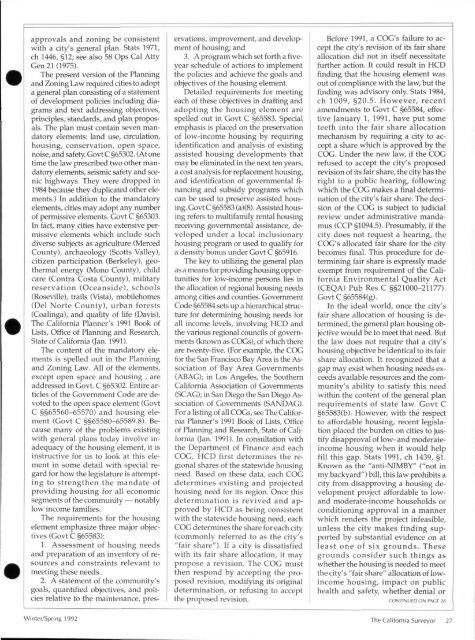You also want an ePaper? Increase the reach of your titles
YUMPU automatically turns print PDFs into web optimized ePapers that Google loves.
approvals and zoning be consistent<br />
with a city's general plan. Stats 1971,<br />
ch 1446, §12; see also 58 Ops Cal Atty<br />
Gen 21 (1975).<br />
<strong>The</strong> present version of the Planning<br />
and Zoning Law required cities to adopt<br />
a general plan consisting of a statement<br />
of development policies including diagrams<br />
and text addressing objectives,<br />
principles, standards, and plan proposals.<br />
<strong>The</strong> plan must contain seven mandatory<br />
elements: land use, circulation,<br />
housing, conservation, open space,<br />
noise, and safety. Govt C §65302. (At one<br />
time the law prescribed two other mandatory<br />
elements, seismic safety and scenic<br />
highways. <strong>The</strong>y were dropped in<br />
1984 because they duplicated other elements.)<br />
In addition to the mandatory<br />
elements, cities may adopt any number<br />
of permissive elements. Govt C §65303.<br />
In fact, many cities have extensive permissive<br />
elements which include such<br />
diverse subjects as agriculture (Merced<br />
County), archaeology (Scotts Valley),<br />
citizen participation (Berkeley), geothermal<br />
energy (Mono County), child<br />
care (Contra Costa County), military<br />
reservation (Oceanside), schools<br />
(Roseville), trails (Vista), mobilehomes<br />
(Del Norte County), urban <strong>for</strong>ests<br />
(Coalinga), and quality of life (Davis),<br />
<strong>The</strong> Cali<strong>for</strong>nia Planner's 1991 Book of<br />
Lists, Office of Planning and Research,<br />
State of Cali<strong>for</strong>nia Qan. 1991).<br />
<strong>The</strong> content of the mandatory elements<br />
is spelled out in the Planning<br />
and Zoning Law. All of the elements,<br />
except open space and housing , are<br />
addressed in Govt. C §65302. Entire articles<br />
of the Government Code are devoted<br />
to the open space element (Govt<br />
C §§65560-65570) and housing element<br />
(Govt C §§65580-65589.8). Because<br />
many of the problems existing<br />
with general plans today involve inadequacy<br />
of the housing element, it is<br />
instructive <strong>for</strong> us to look at this element<br />
in some detail with special regard<br />
<strong>for</strong> how the legislature is attempting<br />
to strengthen the mandate of<br />
providing housing <strong>for</strong> all economic<br />
segments of the community — notably<br />
low income families.<br />
<strong>The</strong> requirements <strong>for</strong> the housing<br />
element emphasize three major objectives<br />
(Govt C §65583):<br />
1. Assessment of housing needs<br />
and preparation of an inventory of resources<br />
and constraints relevant to<br />
meeting these needs.<br />
2. A statement of the community's<br />
goals, quantified objectives, and policies<br />
relative to the maintenance, preservations,<br />
improvement, and development<br />
of housing; and<br />
3. A program which set <strong>for</strong>th a fiveyear<br />
schedule of actions to implement<br />
the policies and achieve the goals and<br />
objectives of the housing element.<br />
Detailed requirements <strong>for</strong> meeting<br />
each of these objectives in drafting and<br />
adopting the housing element are<br />
spelled out in Govt C §65583. Special<br />
emphasis is placed on the preservation<br />
of low-income housing by requiring<br />
identification and analysis of existing<br />
assisted housing developments that<br />
may be eliminated in the next ten years,<br />
a cost analysis <strong>for</strong> replacement housing,<br />
and identification of governmental financing<br />
and subsidy programs which<br />
can be used to preserve assisted housing.<br />
Govt C §65583 (a)(8). Assisted housing<br />
refers to multifamily rental housing<br />
receiving governmental assistance, developed<br />
under a local inclusionary<br />
housing program or used to qualify <strong>for</strong><br />
a density bonus under Govt C §65916.<br />
<strong>The</strong> key to utilizing the general plan<br />
as a means <strong>for</strong> providing housing opportunities<br />
<strong>for</strong> low-income persons lies in<br />
the allocation of regional housing needs<br />
among cities and counties. Government<br />
Code §65584 sets up a hierarchical structure<br />
<strong>for</strong> determining housing needs <strong>for</strong><br />
all income levels, involving HCD and<br />
the various regional councils of governments<br />
(known as COGs), of which there<br />
are twenty-five. (For example, the COG<br />
<strong>for</strong> the San Francisco Bay Area is the Association<br />
of Bay Area Governments<br />
(ABAG); in Los Angeles, the Southern<br />
Cali<strong>for</strong>nia Association of Governments<br />
(SCAG); in San Diego the San Diego Association<br />
of Governments (SANDAG).<br />
For a listing of all COGs, see <strong>The</strong> Cali<strong>for</strong>nia<br />
Planner's 1991 Book of Lists, Office<br />
of Planning and Research, State of Cali<strong>for</strong>nia<br />
(Jan. 1991). In consultation with<br />
the Department of Finance and each<br />
COG, HCD first determines the regional<br />
shares of the statewide housing<br />
need. Based on these data, each COG<br />
determines existing and projected<br />
housing need <strong>for</strong> its region. Once this<br />
determination is revived and approved<br />
by HCD as being consistent<br />
with the statewide housing need, each<br />
COG determines the share <strong>for</strong> each city<br />
(commonly referred to as the city's<br />
"fair share"). If a city is dissatisfied<br />
with its fair share allocation, it may<br />
propose a revision. <strong>The</strong> COG must<br />
then respond by accepting the proposed<br />
revision, modifying its original<br />
determination, or refusing to accept<br />
the proposed revision.<br />
Be<strong>for</strong>e 1991, a COG's failure to accept<br />
the city's revision of its fair share<br />
allocation did not in itself necessitate<br />
further action. It could result in HCD<br />
finding that the housing element was<br />
out of compliance with the law, but the<br />
' finding was advisory only. Stats 1984,<br />
ch 1009, §20.5. However, recent<br />
amendments to Govt C §65584, effective<br />
January 1, 1991, have put some<br />
teeth into the fair share allocation<br />
mechanism by requiring a city to accept<br />
a share which is approved by the<br />
COG. Under the new law, if the COG<br />
refused to accept the city's proposed<br />
revision of its fair share, the city has the<br />
right to a public hearing, following<br />
which the COG makes a final determination<br />
of the city's fair share. <strong>The</strong> decision<br />
of the COG is subject to judicial<br />
review under administrative mandamus<br />
(CCP §1094.5). Presumably, if the<br />
city does not request a hearing, the<br />
COG's allocated fair share <strong>for</strong> the city<br />
becomes final. This procedure <strong>for</strong> determining<br />
fair share is expressly made<br />
exempt from requirement of the Cali<strong>for</strong>nia<br />
Environmental Quality Act<br />
(CEQA) Pub Res C §§21000-21177).<br />
Govt C §65584(g).<br />
In the ideal world, once the city's<br />
fair share allocation of housing is determined,<br />
the general plan housing objective<br />
would be to meet that need. But<br />
the law does not require that a city's<br />
housing objective be identical to its fair<br />
share allocation. It recognized that a<br />
gap may exist when housing needs exceeds<br />
available resources and the community's<br />
ability to satisfy this need<br />
within the content of the general plan<br />
requirements of state law. Govt C<br />
§65583(b). However, with the respect<br />
to af<strong>for</strong>dable housing, recent legislation<br />
placed the burden on cities to justify<br />
disapproval of low- and moderateincome<br />
housing when it would help<br />
fill this gap. Stats 1991, ch 1439, §1.<br />
Known as the "anti-NIMBY" ("not in<br />
my backyard") bill, this law prohibits a<br />
city from disapproving a housing development<br />
project af<strong>for</strong>dable to lowand<br />
moderate-income households or<br />
conditioning approval in a manner<br />
which renders the project infeasible,<br />
unless the city makes finding supported<br />
by substantial evidence on at<br />
least one of six grounds. <strong>The</strong>se<br />
grounds consider such things as<br />
whether the housing is needed to meet<br />
the city's "fair share" allocation of lowincome<br />
housing, impact on public<br />
health and safety, whether denial or<br />
CONTINUED ON PACE 28<br />
Winter/Spring 1992 <strong>The</strong> Cali<strong>for</strong>nia <strong>Surveyor</strong> 27
















